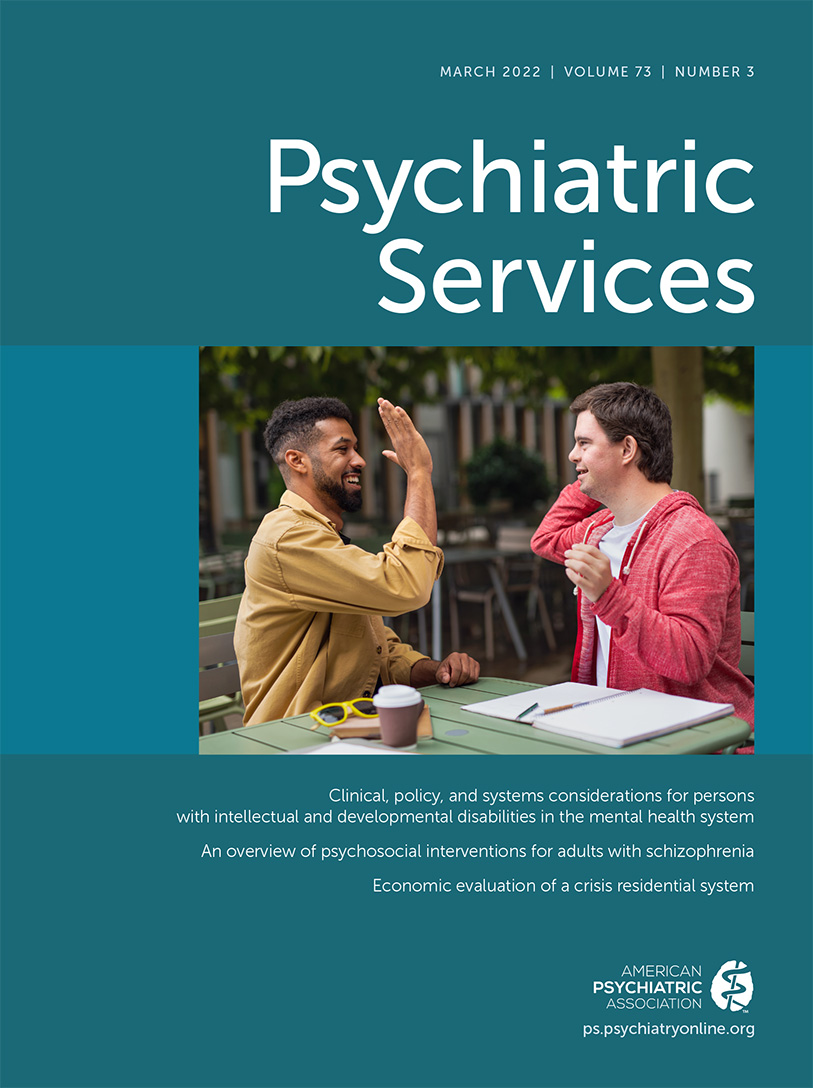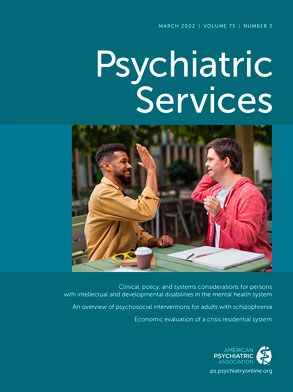The COVID-19 pandemic has disproportionally affected vulnerable populations and has magnified existing disparities in the United States. Lower socioeconomic status, congregate living, greater comorbidity, and limited health care access are thought to drive COVID-19 infection, hospital admission, and mortality (
1). People with serious mental illness often live in congregate settings, have chronic conditions (e.g., obesity, tobacco use, diabetes) (
2), and have difficulty accessing care as they move between the behavioral and general medical health care systems (
3).
Several studies have found that people with serious mental illness are at an increased risk of SARS-CoV-2 infection leading to COVID-19 (
4,
5). Moreover, persons with a psychiatric diagnosis are at an increased risk of death from COVID-19 in the United States (
4,
6). However, these studies grouped serious mental illness diagnoses with other mental and behavioral health diagnoses (e.g., depression, attention-deficit hyperactivity disorder, dementia) (
4,
7) or were limited to a single health care system in the early months of the pandemic (
6). Given the increased psychosocial vulnerability of persons with serious mental illness, greater understanding of the clinical outcomes after COVID-19 is needed. We leveraged a multicenter cohort of more than 2.5 million adults with COVID-19 spanning 12 months to evaluate the likelihood of hospital admission, mechanical ventilation, and mortality after COVID-19 among persons with versus without serious mental illness.
Methods
We used data from TriNetX, a federated network of health systems providing access to deidentified aggregate electronic medical record data for outpatient and inpatient encounters that include insured and uninsured patients (
5,
8). Data include demographic characteristics, diagnostic codes, procedures, medications, anthropomorphic measures, and laboratory values. At the time of this study, data from 63.5 million patients from 49 health systems in the United States were available. The identities and regions of health care organizations were not available in TriNetX to protect against data reidentification. The Johns Hopkins Medicine Institutional Review Board designated this study as nonhuman subjects research.
We identified adults (ages ≥18) diagnosed as having COVID-19 with a visit encounter between January 20, 2020, and January 19, 2021. We established COVID-19 diagnosis by using
ICD-10 codes (B34.2, B97.29, J12.81, U07.1, U07.2) or a positive SARS-CoV-2 laboratory test result by using Logical Observation Identifiers Names and Codes (94500-6, 94315-9, 94533-7, 94534-5, 94559-2) (
5,
8). We excluded patients with an
ICD-10 code of B97.89 to reduce the likelihood of false positive COVID-19 diagnoses because this code is used to indicate an unspecified viral infection.
We used
ICD-10 codes to identify serious mental illness and comorbidity diagnoses associated with severe COVID-19 disease (
5) (see
online supplement). We then extracted information on patient age, sex, and race. Serious mental illness was defined as schizophrenia or a schizoaffective, schizotypal, or bipolar disorder within 5 years of the study period. Comorbid conditions were diabetes, hypertension, ischemic heart disease, obesity, chronic kidney disease, chronic obstructive pulmonary disease, asthma, cerebrovascular disease, nicotine dependence, and substance use disorder.
We examined four outcomes. Among all persons diagnosed as having COVID-19 either in the ambulatory or acute care setting, we examined the likelihood of inpatient admission and mortality within 30 days of a COVID-19 diagnosis. We also examined the likelihood of mechanical ventilation and mortality within 30 days of a COVID-19 diagnosis among a subpopulation of persons hospitalized with a COVID-19 diagnosis. Likelihood of mechanical ventilation was tested only in this subpopulation because its use is restricted to hospitalized patients. Presence of hospital admission and mortality were extracted directly from electronic medical record data. We identified use of mechanical ventilation by using Current Procedural Terminology codes (39.65, 31500, A1935Z, 5A1945Z, 5A1955Z, 1015098, 0BH17EZ, 0BH13EZ, 0BH18EZ, and 1022227) (
8).
We used t tests and chi-square tests to assess differences in group characteristics at baseline. We matched cohorts of individuals with versus without serious mental illness on age (18–44, 45–64, ≥65), sex (male, female), race (White, Black, Asian, other, unknown), ethnicity (Hispanic, non-Hispanic, unknown), and 10 comorbid conditions by using 1:1 matching and a greedy nearest neighbor propensity score approach. We used logistic regression models to examine the association between serious mental illness and COVID-19 clinical outcomes. We conducted sensitivity analyses adjusting by demographic characteristics alone, restricted the time frame to the first 4 months of the pandemic (Feb to May 2020), restricted the sample to those diagnosed as having serious mental illness within 7 years before the study period, and restricted COVID-19 diagnosis to a positive SARS-CoV-2 test.
In additional sensitivity analysis and to assess only symptomatic patients who were hospitalized (as opposed to asymptomatic patients admitted for reasons other than COVID-19), we examined clinical outcomes among patients hospitalized after a COVID-19 diagnosis who received treatment with steroids (dexamethasone, methylprednisolone, hydrocortisone prednisone), which have been shown to reduce mortality in severe COVID-19 cases (
9). Data analysis was performed on the TriNetX platform, which utilizes a combination of JAVA, R, and Python programming (
5,
8).
Results
A total of 2,507,858 people were identified with a diagnosis of COVID-19; of these, 85,257 individuals (3.4%) had serious mental illness, and 2,422,601 individuals (96.6%) did not have serious mental illness in the unmatched cohort. Of the 487,112 people who had an inpatient admission linked to a COVID-19 diagnosis, 27,443 (5.6%) were individuals with serious mental illness, and 459,669 (94.4%) were individuals without serious mental illness in the unmatched subcohort. In the unmatched sample of persons diagnosed with COVID-19, persons with serious mental illness (vs. persons without serious mental illness) were more likely to be younger than age 65 (80.9% [N=68,983] vs. 74.2% [N=1,799,876], p<0.001), female (58.4% [N=49,797] vs. 56.9% [N=1,378,545], p<0.001), Black (22.5% [N=19,146] vs. 14.0% [N=339,146], p<0.001), and non-Hispanic (75.3% [N=64,202] vs. 66.0% [N=1,600,114], p<0.001); they also had at least twice the prevalence of any comorbid condition. Matching eliminated these differences (see
online supplement).
Analyses of the matched sample with COVID-19 showed that people with serious mental illness (vs. without serious mental illness) were more likely to experience hospital admission (27.4% vs. 19.9%; odds ratio [OR]=1.51, 95% confidence interval [CI]=1.48–1.55) and mortality (1.1% vs. 0.9%; OR=1.15, 95% CI=1.05–1.26) (
Table 1). Of the matched subset who were hospitalized with a COVID-19 diagnosis, we found no difference in use of mechanical ventilation (5.3% vs. 5.2%; OR=1.03, 95% CI=0.96–1.11) or mortality (2.5% vs. 2.6%; OR=0.99, 95% CI=0.89–1.10) between persons with or without serious mental illness. Similar findings were observed when we conducted the following sensitivity analyses: adjusted by demographic characteristics alone, restricted the time frame to the first 4 months of the pandemic, restricted the sample to those diagnosed as having serious mental illness within 7 years before the study period, and restricted COVID-19 diagnosis to a positive SARS-CoV-2 test or received steroids during admission (see
online supplement).
Discussion and Conclusions
In this retrospective cohort study of more than two and a half million adults diagnosed as having COVID-19 in the first year of the pandemic, we found that persons with serious mental illness had a significantly higher risk of severe COVID-19 infection leading to hospital admission and death compared with the general population; this outcome was substantiated even after matching on age, sex, race, and comorbid conditions associated with poorer COVID-19 outcomes. When we examined the subset admitted with COVID-19, we observed no differences in use of mechanical ventilation or mortality between persons with versus without serious mental illness.
Prior work has observed an increased mortality risk among persons with any mental or behavioral diagnosis in the United States and in South Korea after COVID-19 diagnosis (
4,
10). Another study observed increased mortality among persons with serious mental illness diagnosed as having COVID-19 in one New York City health care system in the first 4 months of the pandemic (
6). In our work, we have expanded these findings by using data from more than 49 health care systems during the first year of the COVID-19 pandemic.
The increased risk of 30-day mortality after COVID-19 diagnosis among persons with serious mental illness is likely multifactorial. Increased risk of exposure to SARS-CoV-2 and comorbidity are thought to be key drivers of COVID-19–related mortality among racial-ethnic minority populations (
11). Similarly, persons with serious mental illness have elevated risk of exposure on the basis of living situation (e.g., homelessness, congregate living) and use of public services (e.g., public transportation) (
12) and have higher rates of comorbidity. They also may experience cognitive and social barriers (e.g., small support networks) to accessing health care, leading them to seek medical care later in the course of illness and to be sicker upon presentation to medical care (
12). These latter two considerations may help explain why persons with serious mental illness were more likely than those without serious mental illness to be admitted to the hospital after COVID-19 diagnosis. Further work is needed to elucidate potential differences in severity of clinical presentation among persons with versus without serious mental illness.
It is important to note that we did not observe significant mortality differences when we examined the subpopulation with a hospital admission linked to COVID-19. This finding suggests that when persons with serious mental illness access acute care services for COVID-19, disparities in mortality rates narrow. We hypothesize that reduced mortality is related to receipt of supportive care, such as supplemental oxygen, steroids, and management of COVID-19 complications, including acute kidney injury, venous thromboembolism, cardiac arrhythmias, and other organ failures (
9).
Our findings underscore the importance of overcoming structural barriers and improving access to care for persons with serious mental illness. Access to insurance and outpatient treatments, such as monoclonal antibody infusions, have the potential to change the clinical course for patients at risk for severe cases of COVID-19 (
13,
14). Future work is needed to understand barriers and health care–seeking behaviors among persons with serious mental illness during the COVID-19 pandemic; moreover, researchers should determine whether differences exist between persons with serious mental illness who have a strong linkage to mental and general medical health care services versus those without access to these services.
Our study had several limitations. First, our study relied on
ICD-10 codes for diagnosis of serious mental illness and comorbid conditions, which may be incomplete for individuals. We included only those with a COVID-19 diagnosis; moreover, we were not able to assess those who were not tested or who had differential access to testing on the basis of living situation (e.g., congregate settings, homelessness, social isolation). Second, we could not account for patients’ primary reason for hospital admission and may have included asymptomatic patients diagnosed as having COVID-19. However, given that chronic conditions increase the likelihood for severe COVID-19 (
9) and that people with serious mental illness are more likely to have chronic conditions, it is likely that people with serious mental illness were at least as medically ill as those without serious mental illness who were hospitalized. Third, we were unable to match on factors such as patients’ socioeconomic status, neighborhood characteristics, insurance status, health care organization, or region, which may account for differences in access to care or care utilization. However, we used a large sample size and matched on 23 characteristics, including race and ethnicity, which are associated with wider structural inequities (
15). Finally, our study was limited to the 49 health care systems that participate in the TriNetX research consortium, and we were unable to account for individuals who died outside of the affiliated health care systems.
Persons with serious mental illness have had historic difficulty navigating and receiving care across behavioral and general medical health care providers (
4). We observed disparities in overall mortality among persons with serious mental illness but not in the subpopulation admitted to the hospital, suggesting that mechanisms underlying COVID-19 disparities lie outside of the acute care domain.

